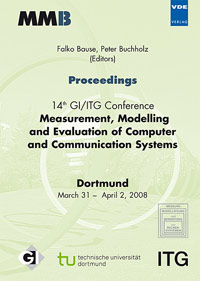Placing Multiple Sinks in Time-Sensitive Wireless Sensor Networks using a Genetic Algorithm
Konferenz: MMB 2008 - 14th GI/ITG Conference - Measurement, Modelling and Evalutation of Computer and Communication Systems
31.03.2008 - 02.04.2008 in Dortmund, Germany
Tagungsband: MMB 2008
Seiten: 15Sprache: EnglischTyp: PDF
Persönliche VDE-Mitglieder erhalten auf diesen Artikel 10% Rabatt
Autoren:
Poe, Wint Yi; Schmitt, Jens B. (disco - Distributed Computer Systems Lab, University of Kaiserslautern, Germany)
Inhalt:
Performance issues in Wireless Sensor Networks (WSNs) play a vital role in many applications. Often the maximum allowable message transfer delay must be bounded in order to enable time-sensitive applications of WSNs like fire or intrusion detection systems. Hence, it is crucial to develop algorithms that minimize the worst-case delay in WSNs. In this work, we focus on the problem of placing multiple sinks such that the maximum worst-case delay is minimized while keeping the energy consumption as low as possible. For that purpose we develop an algorithm based on the Genetic Algorithm (GA) paradigm. To model and consequently control the worst-case delay of a given WSN we build upon the so-called sensor network calculus. In order to be able to assess the performance of the GA-based sink placement strategy we compare it to an exhaustive search algorithm as well as a Monte-Carlo search. All of the strategies are based on a discretization of the originally continuous search space into a finite search space, which forms a contribution of our work of independent interest. In the performance comparison with the other strategies the GA exhibits a favourable behaviour with respect to the quality of the solutions found and the computational effort invested. It thus seems to be a good candidate for addressing the problem of placing multiple sinks in large-scale time-sensitive WSNs.


